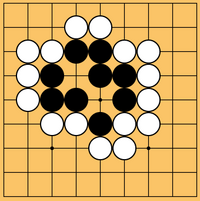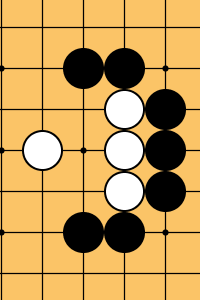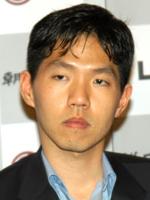Just starting out? Then do this tutorial. Don't rush through it; give each section time and attention to let it soak in. If you don't think you totally understand the rules of Go, do it until you're comfortable.
Introductory stage (30k-20k)[]
After you're done with this tutorial, you should be around 30 kyu, the first rank every Go player starts at. You'll want to learn some Go terms. The most important when beginning are aji, atari, fuseki, gote, hane, joseki, ko, keima, miai, moyo, seki, sente, tenuki, tesuji and yose. Most other Go terms aren't used nearly as much as these.
Now you need to start playing games. I would recommend playing on 9x9 until you have a firm grip on the most basic life and death problems (tsumego) found here (under Entrance level -> Entrance 1240). Also, take a look at this example game to get an idea on how most games of Go play out. A bad habit I find amongst beginners is their penchant for playing self-atari moves or clamping on the first line; you shouldn't be throwing stones into impossible-to-live situations and playing on the first line is generally left for the endgame.
Why don't you take a break and learn a little bit about Professional Go?
As a guide, I would recommend playing at the very least one game a day and solving ten life and death problems a day. If you have the time and are willing to dedicate it towards Go, then try five games a day and fifty life and death problems. When you're just beginning, the more work you put into it, the faster you will improve.
For the life and death problems, you should focus on trying to complete the problems listed under the "Basic" heading here (under Entrance level). There are 900 different problems. The more you do, the faster your strength, reading power and calculation will rise. If you do the minimum of ten per day, it should take you three months. If you do 50, it will take you a little over a fortnight. You can go ahead and do as many as you like, but make sure you're reading and not clicking around.

Quick refresher to see if you've followed the interactive guide: Is the black group alive?
If you have trouble solving these problems, let us know and we will be glad to help you. Most problems shouldn't take longer than one minute to solve. If you find yourself without a solution after ten minutes, then abandon the problem and focus on easier ones.
Guide to solving life and death problems[]
As an aside, let me leave you with this tip on solving life and death problems by master player Cho Chikun, the most decorated player in Japanese Go. Finding the first move is half the work, but remember, it is still only half the work. If you cannot read the following four moves, then you must practice until you can.
The Double-Digit Kyu stage (19k-10k)[]
By now you should have the basic idea of life and death. Next, you'll want to focus on how games are actually played.
Although Go is about who surrounds the most territory in the end, your aim shouldn't be to wall off your territory. Go is all about efficiency. The player who plays the most efficient moves will win. See this and this to mold a rough draft on what efficiency in Go is.
All Go games start with an empty board. Playing Go is much like building a house. First, you must start with the foundation, or the corners. Then, you want to move on to the walls, or the sides. Finally, you'll want to add a roof, or the center. Remember: 1. corner, 2. sides, 3. center. Review this list. Some of these principles will not make sense, but as you get stronger you will realize why these principles are so important.
In addition to your daily ten tsumego (life and death) problems a day, you should review these fuseki (opening) exercises and a small list of joseki (set patterns) that every double-digit kyu should know.
Take a look at some Reviewed games to see Go from the perspective of a stronger player.
Reading list (15k-5k)[]

Lessons in the Fundamentals of Go is universally considered the best book on Go.
There are five books I highly recommend to study along with your daily routine. These are:
- Lessons in the Fundamentals of Go by Toshiro Kageyama 7 dan
- Opening Theory Made Easy by Otake Hideo 9 dan
- Tesuji by James Davies
- Attack and Defense by Ishida Akira 9 dan
- Strategic Concepts of Go by Nagahara Yoshiaki 6 dan
The books should be read in the order they are listed. Do not try and power through these. You cannot simply memorize a diagram from a book and expect to progress. You must learn it. Read one chapter in the morning, play a game, review the chapter and see where you followed/missed the principles laid out in the chapter, and read it once more before going to sleep.

A common tesuji. After black plays 5, white can't fill at 1 because he will be captured.
Learn. Don't memorize.
Do the problems found in those books in addition to twenty-five tsumego a day. If you can do fifty tsumego plus the additional problems, then more power to you.
Getting to 10k is easy. However, gaining a stone when you're a single-digit-kyu is a much harder task.
First Kyu (9k-1k)[]
Now you'll want to zero in and get more serious. Instead of playing three or five games a day, focus on playing one game a day that is reviewed by a stronger player. In addition, continue to review the aforementioned books and keep solving tsumego. Once you get to the middle single-digit-kyus, starting learning some joseki.
See a position pop up in a game you just played and you don't know what the right follow-up was? Review it with a stronger player and they'll show you numerous variations which work or don't work. You could do it yourself by using this handy joseki dictionary, but having a stronger player explain why Move A worked when Move B didn't will maximize your learning. Once you have finished the tsumego listed underneath the intermediate level (2000+), move on to the advanced level.
If the problems are too difficult, go back and review the basics ones. It's better to do easy problems you can solve than hard ones you can't.

- Q: How many moves ahead do you read before you play a move?
- A: Usually professional players, including me, read around 100 moves ahead. But that's not the case for every move. First, select 10 candidate moves and then read ahead for each of them. After reading ahead 20 to 30 moves for a candidate move, one could reach a tentative conclusion like "this is a bad shape" or simply "this is not it." At that point, I stop any further reading for that candidate move and look for another. This is a process of elimination that usually leaves one or two candidate moves. For each of these final candidate moves, I read ahead about 100 moves. This might surprise amateur players, but the more difficult thing is not reading ahead 100 moves, but deciding which of the final cadidate moves gives a better result. .... The most painful moment is when I realize that I am on the wrong way a few moves after my original decision. That gives me an agony beyond description. - Lee Changho
Once you get to around 5 kyu, there are a few more books that I highly recommended.
- Direction of Play by Takeo Kajiwara 9 dan
- Positional Judgement by Cho Chikun 9 dan
- Reducing Territorial Frameworks by Fujisawa Shuko 9 dan
These books are advanced and will teach you deep Go theory and concept that the other books didn't. Another great strengthening tool in addition to playing, reading and solving tsumego is to review professional games. You can read more about it here.
If you're a territorial player, review the games of Pak Yeong-hun and Kobayashi Koichi. If you're an attacker, check out Kato Masao and Lee Sedol. If you like building big moyos, then studying Takemiya Masaki would be best.

Lee Sedol (R) is a lethal attacker known for his exceptional reading. Check out this game for an example. Here's a little context: Lee read out a ladder that didn't work and still played it in order to kill the bottom right. He later went on to make the entire bottom left a seki (mutual life). Oh, I forgot to mention, this was during a hayago tournament - he had something like 30 seconds per move. The power of pros is mysterious.
If you've done all this, then congratulations, you should be at least 2 kyu on KGS. I don't have much more knowledge to impart on you, besides this article. I'm currently in the process of doing what is listed in that article. Hopefully in the future this page will be filled with much more information to help you future beginners.
Remember, we all start out as beginners.
"No doubt the first requirement for becoming strong at go is to like it, like it more than food or drink, and a second requirement is the desire to learn. A third requirement is to study it, using proper methods, patiently, little by little, without cramming... Rome was not built in a day. It may not take years of devoted study to the exclusion of all else, but it does take effort piled upon effort to become strong at go. The only ones who fall by the wayside are those, be they gifted or otherwise, who forget the word 'effort'" - Kageyama